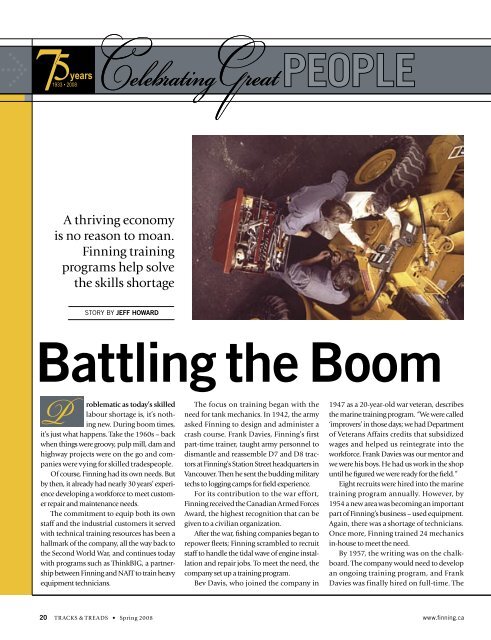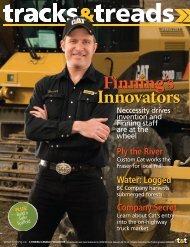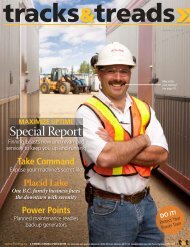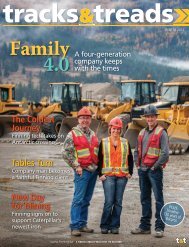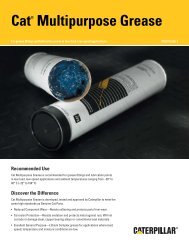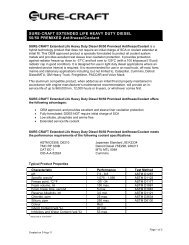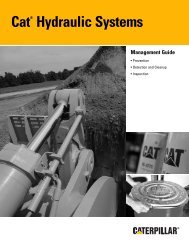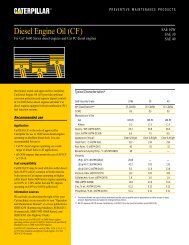A thriving economyis no reason to moan.<strong>Finning</strong> trainingprograms help solvethe skills shortageStory by Jeff HowardBattling the Boomroblematic as today’s skilledlabour shortage is, it’s nothingnew. During boom times,it’s just what happens. Take the 1960s – backwhen things were groovy, pulp mill, dam andhighway projects were on the go and companieswere vying for skilled tradespeople.Of course, <strong>Finning</strong> had its own needs. Butby then, it already had nearly 30 years’ experiencedeveloping a workforce to meet customerrepair and maintenance needs.The commitment to equip both its ownstaff and the industrial customers it servedwith technical training resources has been ahallmark of the company, all the way back tothe Second World War, and continues todaywith programs such as ThinkBIG, a partnershipbetween <strong>Finning</strong> and NAIT to train heavyequipment technicians.The focus on training began with theneed for tank mechanics. In 1942, the armyasked <strong>Finning</strong> to design and administer acrash course. Frank Davies, <strong>Finning</strong>’s firstpart-time trainer, taught army personnel todismantle and reassemble D7 and D8 tractorsat <strong>Finning</strong>’s Station Street headquarters inVancouver. Then he sent the budding militarytechs to logging camps for field experience.For its contribution to the war effort,<strong>Finning</strong> received the Canadian Armed ForcesAward, the highest recognition that can begiven to a civilian organization.After the war, fishing companies began torepower fleets; <strong>Finning</strong> scrambled to recruitstaff to handle the tidal wave of engine installationand repair jobs. To meet the need, thecompany set up a training program.Bev Davis, who joined the company in1947 as a 20-year-old war veteran, describesthe marine training program. “We were called‘improvers’ in those days; we had Departmentof Veterans Affairs credits that subsidizedwages and helped us reintegrate into theworkforce. Frank Davies was our mentor andwe were his boys. He had us work in the shopuntil he figured we were ready for the field.”Eight recruits were hired into the marinetraining program annually. However, by1954 a new area was becoming an importantpart of <strong>Finning</strong>’s business – used equipment.Again, there was a shortage of technicians.Once more, <strong>Finning</strong> trained 24 mechanicsin-house to meet the need.By 1957, the writing was on the chalkboard.The company would need to developan ongoing training program, and FrankDavies was finally hired on full-time. The20 tracks & treads • Spring 2008 www.finning.ca
company was asked to take on the administrationof the province’s first four-year heavyduty technician apprenticeship program,because the Vancouver Vocational Institutehad neither the instructors nor the facilities.The strategic move included governmentsupervision and assistance.Reporting on this development, Truck Loggermagazine described <strong>Finning</strong> training as“the most ambitious industrial training programin the province … Several constructionand logging firms have taken advantage of the<strong>Finning</strong> program to include some of their mechanicsin the schedule. The program will domuch to alleviate the [labour] shortage.”Four years later, <strong>Finning</strong> was able to advertisethe merits of its experts. Bev Davis,the former “improver,” had moved into <strong>service</strong>management in Vancouver. In a letter tocustomers, he wrote, “There are 159 <strong>Finning</strong>mechanics (or technicians) at your <strong>service</strong>throughout B.C. They’re trained experts withspecial tools and proper working conditions.They’re the men who give you the best job,worth the little bit extra they may cost.”In 1966, <strong>Finning</strong>’s population of technicianshad expanded to 434. From 1964 to1966, mechanical staff in Vancouver haddoubled. It was a reflection of a businesssurge at <strong>Finning</strong> and, more generally, in B.C.Jack Rollins, one of the company’s originalsix employees, said at the time: “The supplyof technicians doesn’t come near to meetingthe demand.”During a 1966 interview with WesternBusiness and Industry magazine, <strong>Finning</strong> presidentMaury Young said <strong>Finning</strong> wouldn’tlower hiring standards to fill shortfalls. “Wedon’t choose to go this route no matter howcritical the shortage becomes,” he said. “Wefeel it’s in our interest to do fewer jobs well,rather than turn out poor work. The solutionlies in extensive in-plant training.”That proposed solution was put intoaction, and <strong>Finning</strong> became <strong>Canada</strong>’s firstprivate company training school, by the federalgovernment’s definition. The Journal ofCommerce reported in 1973 that <strong>Finning</strong> was“a company fast earning a national reputationfor its ability to train people.”Also in 1973, <strong>Finning</strong> launched B.C.’s firstparts apprenticeship program. The three-yearprogram received the blessing of the apprenticeshipand industrial training branch of theprovincial labour department and the InternationalAssociation of Machinists and AerospaceWorkers.By the end of 1977, more than 150 companiesfrom across <strong>Canada</strong> had sent personnelto take <strong>Finning</strong> courses. Erroll Inglis,program head, said, “The biggest percentageof our business comes from industry, askingus to upgrade the skills of their employees.”Today, amidst another labour shortage,<strong>Finning</strong> continues to focus on developingwell-trained employees, able to provide optimumcustomer <strong>service</strong>. The company employs384 apprentices in six different fields:heavy equipment, parts, machining, electrical,welding and millwright.Last year, <strong>Finning</strong>’s team of 22 technicaltrainers delivered nearly 400 technical trainingclasses to more than 1,200 <strong>Finning</strong> employees.In 2007, nearly 80% of employeeshad participated in some kind of companytraining. <strong>Finning</strong> also offers customer andoperator training.“Our success depends on people whocan listen to our customers, solve problemsquickly, focus on quality and take initiative,”company president Ian Reid says. “Therefore,training and development will continue to beour highest priorities.”Not even a tank could stop this 66-yeartraining tradition.TRADITION OF LEARNING: Frank Davies,(dark suit), conducts a course for <strong>Finning</strong>customers and employees. Below: <strong>Finning</strong>trainer Lyle Troudt continues the traditionwww.finning.ca Spring 2008 • tracks & treads 21


